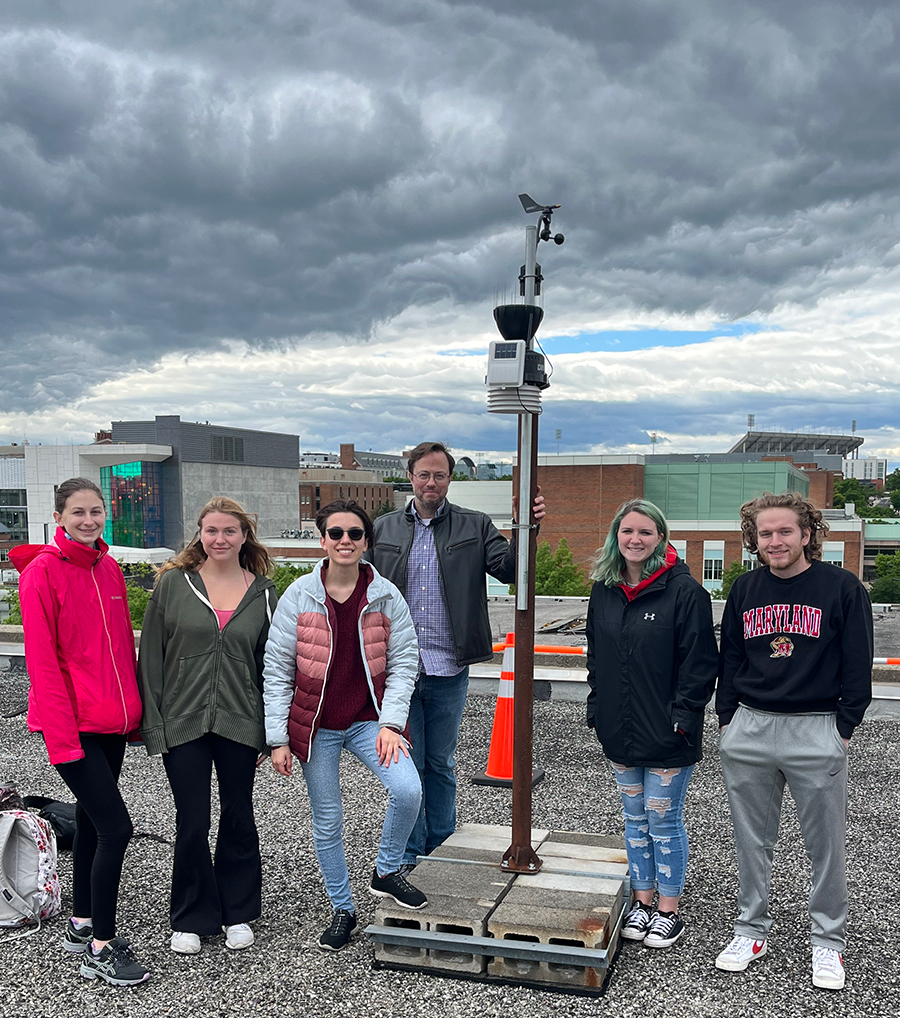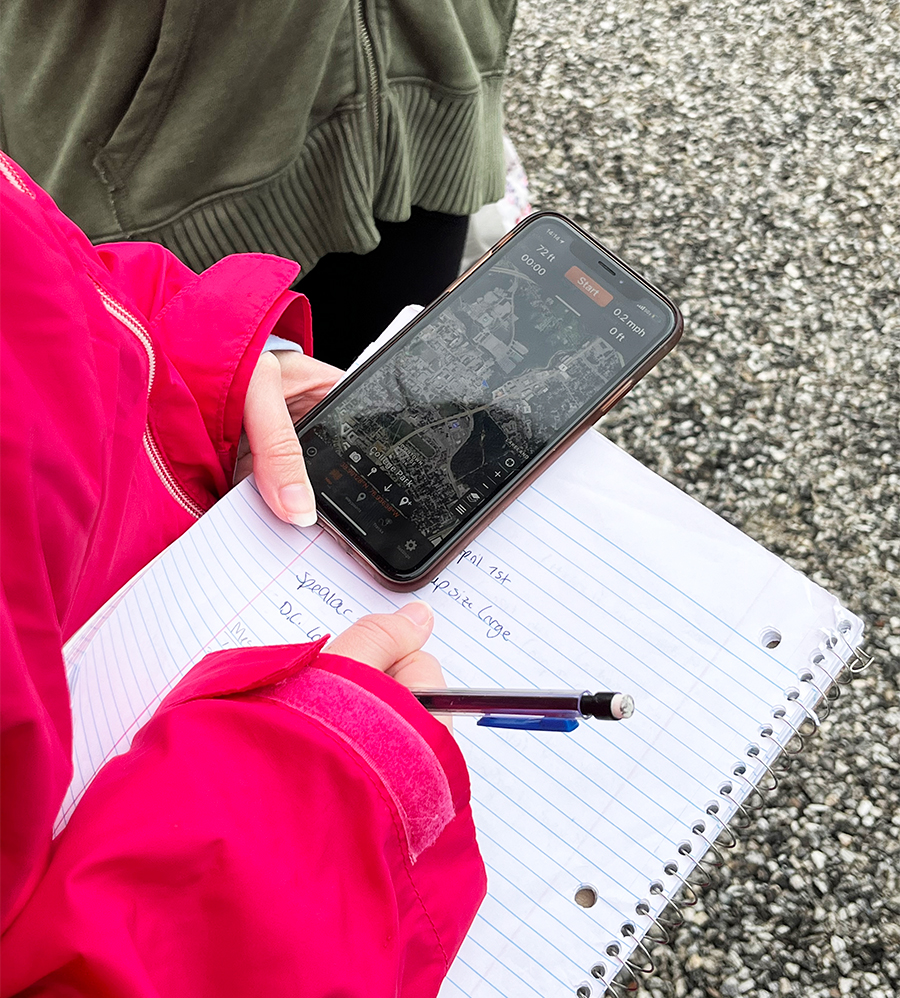UMD Students Build Micronet to Bring Hyperlocal Weather Reports to Campus
Three campus weather stations are up and running, with plans to install seven more.
If you want to know the current temperature at the University of Maryland, you may need to get a little more specific. That’s because the temperature often varies by two degrees or more from one end of campus to the other.
On one Wednesday afternoon in June, it was 75.6 degrees outside of the Atlantic Building, but a balmier 77.3 degrees at the A.V. Williams Building. The UMD golf course, with its ample grass and open space, is generally cooler than both of those locations in spring and summer.

Students in the Department of Atmospheric and Oceanic Science (AOSC) made these hyperlocal weather reports possible by installing and managing a micronet—a small-scale network of weather sensors—across UMD’s campus. The project is funded by the department; the Maryland and Delaware Climate Change Education, Assessment and Research program (MADE-CLEAR); and a gift from AOSC Adjunct Professor Robert Brammer (M.A. ’70, Ph.D. ’72, mathematics).
Three weather stations provide minute-by-minute updates on the temperature, wind speed, pressure, dew point and rain rate, and there are plans to install seven more stations across campus in the near future. The students managing the micronet also hope to develop a system that would alert subscribers to heavy rainfall or high winds.
AOSC Associate Professor Timothy Canty, faculty lead of the micronet project, said their weather network accomplishes two main goals: It engages students in hands-on research and keeps campus informed about severe weather events like last summer’s storm. One year ago, a powerful storm clamored across campus, with peak wind speeds of 80 to 90 miles per hour. It left a trail of uprooted trees and power outages in its wake, but no one on campus was injured.
“We know that bad weather hits campus, whether it’s tornadoes or microbursts or snow,” Canty said. “Having this information—and having so many stations in such a small area—provides a much more detailed look at what’s going on.”
A project revived
AOSC purchased the weather stations for the micronet program several years ago, but the COVID-19 pandemic thwarted installation plans.
“When the pandemic hit, everything just stayed boxed up,” Canty said. “The first one went up on the roof of the Atlantic Building, but that was it for the longest time.”
When Canty mentioned the stalled project during his AOSC 200: Weather and Climate class in spring 2022, it piqued the interest of AOSC and mathematics double-degree student Maria Nikolaitchik.
“I’m a data nerd, and it sounded like a lot of cool data to see and set up,” Nikolaitchik said. “I thought, ‘OK, let’s give this a shot and see what we can cobble together.’”

As the project’s student lead, Nikolaitchik picked up where a previous student, Tyler Boyle (B.S. ’18, AOSC), left off. Boyle laid the groundwork for the project by finding an open-source software that could read the weather station data, and Nikolaitchik helped implement that software to send data to a centralized server. In order to transmit data from the weather stations to the server, Nikolaitchik used a Raspberry Pi—a low-cost mini-computer that is effective at singular tasks.
Over time, other AOSC students got involved and formed a group called the Mesoterps in homage to weather terminology. In May, they helped install the newest weather station atop the A.V. Williams Building, while also handling the logistics of processing, storing and communicating the incoming weather data to a wider audience.
Malcolm Maas, a physics and AOSC double-degree student, helped create user-friendly graphs to visualize the weather data pouring in. These hyperlocal weather graphs, displayed on the UMD Weather website, are already proving helpful to members of UMD’s community who are frequently out in the elements.
“Facilities Management contacted us and said they’ve been using the rain rate graphs,” Maas said. “In heavy rain events, flooding can be very localized, and they’ve had problems in the past with flooding on campus.”
Brian Trest, manager of the Facilities Management (FM) Incident Response Unit, said the micronet provides real-time campus weather data that has never before existed.
“Over the years, we have found that the publicly available weather data from commercial and public sources were not accurate enough for our needs on campus,” Trest said. “For FM’s Incident Response Unit, summer thunderstorms have been troublesome over the past few years. Significant rainfall events with highly localized downpours have washed out the campus and left areas just off campus dry.”
Not just a weather network
The micronet complements a larger initiative called the Maryland Mesonet. Announced last October as a partnership between the state of Maryland and UMD, the Mesonet will be a network of 75 weather observation towers across the state. Between the statewide Mesonet and campus micronet, the influx of hyperlocal weather data will address community-level needs.
The Mesoterps are already scouting locations for their next weather station, with hopes of placing it on the southern end of campus. In the long run, the team hopes to add other features to the network to monitor air quality.

“We can expand the network and add air quality instruments that measure particulate matter and also greenhouse gases,” Canty said. “So this won’t just be a weather network—it will be an environmental network. And I don’t know of anything like this that exists on any other campus.”
Air quality was top of mind for many on campus this summer during a “Code Red” alert caused by the wildfires raging in Canada. Nikolaitchik said in situations like this, the micronet can play a key role in keeping the campus community informed.
“Campus is a constantly growing place, so the micronet allows us to continue to monitor different aspects of campus, especially with increasing wildfires and these sudden changes we’re experiencing,” she said.
As UMD’s micronet expands—both in coverage area and the types of data measured—the Mesoterps want to raise awareness across campus that this weather data exists.
“One of our goals for next semester, besides implementing air quality sensors, is to spread word about our website,”Nikolaitchik said. “Publicly accessible data is only beneficial to the public if the public knows about it.”
Canty said that once campus learns about the micronet’s potential, it could inspire a number of student research projects—and not just in AOSC.
“A lot of student projects will come out of this,” Canty said. “I would love to collaborate with whoever is interested in working with us. The more people who use this, the better it is for everybody.”







